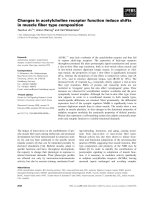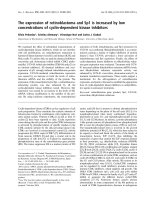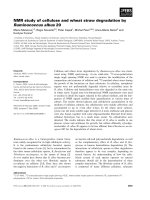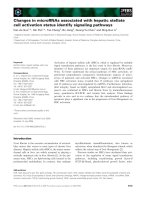Báo cáo khoa học: "Changes in dry weight and nitrogen partitioning induced by elevated CO depend on soil nutrient 2 availability in sweet chestnut (Castanea sativa Mill)" ppt
Bạn đang xem bản rút gọn của tài liệu. Xem và tải ngay bản đầy đủ của tài liệu tại đây (450.77 KB, 8 trang )
Original
article
Changes
in
dry
weight
and
nitrogen
partitioning
induced
by
elevated
CO
2
depend
on
soil
nutrient
availability
in
sweet
chestnut
(Castanea
sativa
Mill)
A EI Kohen
H
Rouhier
M
Mousseau
1
CNRS,
URA
121,
Laboratoire
d’Écologie
Végétale,
Bâtiment
362,
Université
Paris-Sud,
91405
Orsay
Cedex;
2
CEFE-CNRS,
route
de
Mende,
BP
5051, 34033
Montpellier
Cedex,
France
(Received
28
August
1991;
accepted
4
November 1991)
Summary —
The
effect
of
2
levels
of
atmospheric
carbon
dioxide
(ambient,
ie
350
ppm,
and
double,
ie
700
ppm)
and
2
contrasting
levels
of
mineral
nutrition
on
dry
weight,
nitrogen
accumulation
and
partitioning
were
examined
in
2-year-old
chesnut
seedlings
(Castanea
sativa
Mill),
grown
in
pots
out-
doors
throughout
the
vegetative
season.
Fertilization
had
a
pronounced
effet
on
dry
weight
accumu-
lation,
tree
height,
leaf
area,
and
plant
nitrogen
content.
Carbon
dioxide
enrichment
significantly
in-
creased
total
biomass
by
about
20%,
both
on
fertilized
and
on
unfertilized
forest
soil.
However,
the
partitioning
of
biomass
was
very
different:
on
the
unfertilized
soil,
only
the
root
biomass
was
in-
creased,
leading
to
an
increase
in
the
root:
shoot
ratio.
Contrastingly,
on
fertilized
soil
only
stem
bio-
mass
and
diameter
but
not
height
were
increased.
Carbon
dioxide
enrichment
significantly
reduced
the
nitrogen
concentration
in
all
organs,
irrespective
of
the
nutrient
availability.
However,
the
bio-
mass
increase
made
up
for
this
reduction
in
such
a
way
that
the
total
nitrogen
pool
per
tree
re-
mained
unchanged.
elevated
CO
2
/ dry
weight
partitioning
/ nitrogen
partitioning
/ Castanea
sativa
Mill
Résumé —
Les
effets
d’un
enrichissement
en
CO
2
sur
la
répartition
de
la
matière
sèche
et
de
l’azote
chez
le
châtaignier
(Castanea
sativa
Mill)
dépendent
de
la
fertilité
du
sol.
On
a
étudié
l’effet
d’un
doublement
de
la
concentration
en
CO
2
de
l’atmosphère
(soit
350
vpm,
teneur
actuelle
et
700
vpm)
sur
la
répartition
de
la
biomasse
et
du
contenu
en
azote
chez
de jeunes
plants
de
châtai-
gniers
(Castanea
sativa
Mill).
Les
arbres,
âgés
de
2
ans,
sont
cultivés
en
pots
à
l’extérieur
pendant
toute
une
saison
de
végétation
sous
des
tunnels
ou
miniserres
recouvertes
de
propafilm
et
ventilées
en
permanence.
Le
doublement
du
CO
2
ambiant
est
obtenu
par
addition
constante
de
CO
2
pur
d’ori-
gine
industrielle.
Ces
jeunes
châtaigniers
sont
cultivés
sous
nutrition
minérale
contrastée
(sol
fores-
tier
auquel
est
ajouté
ou
non
de
l’engrais
NPK
en
granulés).
Une
fertilisation
du
sol
forestier
d’origine
augmente
nettement
la
biomasse,
la
hauteur
et
la
surface
foliaire
totale
des
arbres,
ainsi
que
leur
contenu
en
azote.
L’augmentation
de
la
biomasse
due
au
doublement
du
CO
2
(de
l’ordre
de
20%)
est
la
même
quelle
que
soit
la
fertilité
du
sol.
Par
contre,
la
répartition
de
la
matière
sèche
est
très
différente
sur
sol
fertilisé
ou
non
fertilisé.
Sur
sol
pauvre,
l’augmentation
de
biomasse
est
uniquement
localisée
dans
les
racines,
d’où
une
augmentation
du
rapport
parties
souterraines/parties
aériennes.
Au
contraire,
sur
sol
fertilisé,
l’augmentation
de
bio-
*
Correspondence
and
reprints
masse
concerne
uniquement
la
partie
aérienne,
dont
la
tige
grossit
en
diamètre
et
non
pas
en
hau-
teur.
L’enrichissement
en
CO
2
réduit
de
manière
significative
la
concentration
en
azote
de
tous
les
or-
ganes,
quel
que
soit
le
degré
de
disponibilité
en
azote
du
sol.
Cependant,
l’augmentation
de
biomasse
des
organes
compense
cette
réduction
de
telle
manière
que
le
pool
d’azote
par
arbre
reste
constant.
enrichissement en
CO
2/
répartition
de
la
matière
sèche
/
distribution
de
l’azote
/ Castanea
sati-
va Mill
INTRODUCTION
Among
the
effects
of
the
increase
in
atmos-
pheric
CO
2,
those
concerning
trees
are
par-
ticularly
important
because
forest
ecosys-
tems
are
the
major
carbon
store
of
the
biosphere.
Earlier
work
on
the
effect
of
ele-
vated
CO
2
on
young
trees
(Eamus
and
Jar-
vis,
1989)
has
shown
a
general
increase
in
total
dry
weight.
Tree
ring
measurements
over
the
past
100
years
(Kienast
and
Lux-
moore,
1988)
have
provided
direct
evi-
dence
of
increase
in
tree
growth,
although
this
has
not
been
directly
related
to
elevat-
ed
CO
2
alone.
One
may
thus
assume
that
an
elevated
CO
2
will
induce
an
increase
in
the
trees’
carbon
storage
despite
wide-
spread
tropical
deforestation
that
is
counter-
acting
this
effect
(Houghton
et al,
1991).
Generally,
tree
responses
to
CO
2
en-
richment
include
an
increase
in
net
photo-
synthesis
and
thereby
in
growth
and
dry
weight
production
(Jarvis,
1989).
In
most
of
the
experiments
reported
in
the
litera-
ture,
nutrients
have
been
supplied
in
suffi-
cient
amounts.
However,
forests
frequently
grow
on
nutrient-poor
soils
and
their
pro-
ductivity
is
strongly
related
to
soil
fertility.
It
has
been
demonstrated
that
a
limitation
in
resources
does
not
preclude
plant
growth
response
to
CO
2
enrichment
(Norby
et
al,
1986b).
However,
the
limit
in
the
CO
2
re-
sponse
may
be
connected
with
the
total
amount
of
nitrogen
that
could
be
obtained
from
a
poor
environment:
growth
stimula-
tion
will
depend
on
the
sink
activity,
which
is
itself
stimulated
by
nutrient
availability
(Cromer
and
Jarvis,
1990).
Sweet
chestnut,
Castanea
sativa
Mill,
is
a
relatively
fast
growing
species,
bearing
large
leaves
with
a
relatively
high
photo-
synthetic
capacity
(Ceulemans
and
Saugi-
er,
1991).
Sweet
chestnut
is
common
in
the
French
deciduous
forest,
being
the
third
major
genus
following
Quercus
and
Fagus
in
terms
of
area
(one
million
hec-
tares)
and
productivity.
These
specific
fea-
tures
make
Castanea
a
good
model
to
in-
vestigate
the
effects
of
elevated
CO
2
on
temperate
tree
species.
The
experiment
reported
here
was
de-
signed
to
investigate
the
effect
of
elevated
CO
2
in
well-watered
trees
under
full
sun-
light
in
2
contrasting
nutrient
situations.
MATERIALS
AND
METHODS
Two-year-old
bare-root
chestnut
seedlings
were
obtained
from
a
forestry
nursery
(Bauchery
et
Fils,
Crouy
sur
Cosson,
La
Ferté-St-Cyr,
France).
The
seedlings
were
planted
in
cylindri-
cal
pots
(25
cm
diameter,
50
cm
height)
filled
with
24
I of
soil.
The
soil
was
taken
from
a
near-
by
chestnut
stand;
it
consisted
of
the
upper
15
cm
organic
layer
of
forest
soil
sifted
and
homo-
genized
after
litter
removal.
The
main
soil
characteristics
were
as
follows:
apparent
density:
1.5
g.cm
3;
field
capacity:
15%
(weight
fraction);
available
water:
10%
(weight
fraction);
cation
exchange
capacity:
26
meq/1
000
g
dry
weight;
total
nitrogen
content:
0.37
g/1
000
g
dry weight;
total
organic
matter:
10.6
g/1
000
g
dry
weight;
C/N.
16.5.
Fertilization
of
the
soil
was
provided
monthly
with
fertilizer
granules
spread
over
the
pots’
sur-
face.
These
mineral
granules
(Engrais
SECO,
Ribécourt,
France)
contained
17%
nitrogen
(6.2
NO
3-
and
10.8
NH
4+
),
17%
P2O5
,
(16%
water-
soluble)
and
17%
K2O
soluble
in
water.
Forty
granules
were
distributed
monthly
in
each
pot,
providing
0.82
g
N,
0.78
g
P
and
0.4
g
K.
These
quantities
were
3
times
as
high
as
the
final
min-
eral
content
of
a
tree
at
the
end
of
1
year’s
growth.
These
nutrients
were
progressively
dis-
solved
into
the
soil
via
an
automatic
drip
system.
Twenty-four
trees
were
planted
in
each
mini-
greenhouse.
For
various
reasons
(pests,
breaks,
etc),
the
number
of
trees
analysed
in
each
experimental
situation
varied
between
16
and
20.
This
number
is
given
in
each
specific
table.
t-Test
was
used
for
comparison
of
means
and
ANOVA
to
assess
the
interaction
between
CO
2
and
fertilization
treatments.
The
pots
were
placed
in
trenches
2
m
long
and
1
m
wide,
covered
with
ventilated
mini-
greenhouses
made
of
polypropylene
films
glued
onto
aluminium
frames
(1
m
high).
Air
was
blown
continuously
over
the
plants
at
a
rate
of
150
l.s
-1
which
was
sufficient
to
maintain
the
air
temperature
close
to
that
of
the
outside
air
(+
2
°C
max).
In
half
of
these
mini-greenhouses,
a
double
CO
2
concentration
(ie,
700
ppm)
was
maintained
with
pure
industrial
CO
2
introduced
at
a
constant
rate
(120
l.h
-1
)
into
the
main
air
flow.
The
other
half
was
ventilated
with
normal
air.
The
trees
were
watered
daily
with
tap
water
in
order
to
compensate
for
daily
evapotranspira-
tion
(ie
about
200
g
water
per
pot).
Total
leaf
area
per
tree
was
computed
by
measurements
of
length
(L)
and
width
(W)
of
all
leaves
(S
=
L
x W
x
0.65).
After
leaf
fall,
all
dead
leaves
were
collected
and
weighed.
Later,
in
January,
the
plants
were
dug
up,
roots
were
washed
under
water,
and
shoot
and
root
dry
weight
were
evaluated.
RESULTS
Dry
weight
partitioning
Figure
1
shows
the
effect of
a
double
CO
2
on
the
dry
weight
partitioning
between
shoots
and
roots
in
the
fertilized
and
unfer-
tilized
situation.
In
normal
air,
there
was
more
than
a
doubling
in
dry
biomass
pro-
duction
of
the
seedling
with
the
increase
in
nutrient
availability.
This
confirms
that
trees’
mineral
nutrition
was
a
strong
growth
limiting
factor.
It
can
also
be
noticed
that
fertilization
enhanced
the
shoot
(x
3)
pro-
duction
more
than
the
root
(x
2)
produc-
tion.
It
followed
that
the
root/shoot
ratio
decreased
significantly,
as
previously
de-
scribed
(Agren
and
Ingestad,
1987).
The
percentage
of
total
dry
weight
in-
crease
due
to
CO
2
enrichment
was
equiva-
lent
in
the
unfertilized
or
fertilized
situation:
the
doubling
of
atmospheric
CO
2
was
re-
sponsible
for
an
increase
of
about
20%
in
total
dry
weight.
However,
CO
2
enrichment
had
a
specific
effect
on
dry
weight
parti-
tioning
to
roots
and
shoots:
on
poor
forest
soil,
the
whole
dry
weight
increase
due
to
elevated
CO
2
was
allocated
to
the
roots.
The
stem
dry
weight
had
been
reported
to
be
negatively
affected
by
elevated
CO
2
in
this
species
(Mousseau
and
Enoch,
1989)
which
was
not
significant
in
the
present
ex-
periment.
Contrastingly,
on
the
fertilized
soil,
ele-
vated
CO
2
affected
mostly
stem
+
branch-
es
(+
33%)
and
litter
(+
35%)
dry
weight
accumulation
(fig
1).
A
significant
interac-
tion
between
fertilization
and
CO
2
treat-
ment
was
observed
for
these
parameters
(F
=
5.06
and
5.39
respectively;
df
=
1.67).
The
corresponding
increase
in
root
dry
weight,
although
noticeable
in
figure
1,
was
not
significant
at
P
<
5%
and
no
inter-
action
was
noted.
In
both
fertilized
and
unfertilized
situa-
tion,
neither
an
increase
in
stem
length
nor
any
effect
on
branching
due
to
the
CO
2
treatment
was
noted
(results
not
shown)
although
it
has
been
reported
in
other
spe-
cies
(Sionit
et al,
1985).
Therefore,
when
stem
dry
weight
was
increased
(ie
in
the
fertilized
situation),
this
was
mainly
due
to
stem
diameter
increase
(table
I).
No
effect
of
elevated
CO
2
could
be
not-
ed
on
leaf
area
development
in
unfertilized
trees
(table
I)
as
reported
earlier
(Mous-
seau
and
Enoch,
1989).
This
was
not
the
case
with
fertilized
trees,
for
which
leaf
area
per
plant
was
significantly
increased
by
the
CO
2
treatment
(table
I).
Nitrogen
distribution
within
the
trees
Under
both
fertilization
treatments,
elevated
CO
2
decreased
nitrogen
concentration
in
all
organs.
This
decrease
was
especially
signif-
icant
in
roots
(table
II).
Litter
(and
not
leaf)
nitrogen
content
is
mentioned
in
table
II
be-
cause
the
analyses
were
performed
in
win-
ter,
after
leaf
fall
and
nitrogen
redistribution
to
other
plant
parts.
The
analysis
made
on a
few
green
leaves
at
the
end
of
the
growing
season
(before
yellowing:
1st
September)
showed
a
decrease
in
leaf
nitrogen
concen-
tration
in
response
to
CO
2
enrichment
simi-
lar
to
that
found
in
other
organs,
irrespective
of
the
fertilization
treatment
(table
III).
More
nitrogen
in
the
soil
increased
the
overall
nitrogen
concentration
and
content
of
the
seedlings.
The
nutrient
pool
sizes
were
calculated
by
multiplying
the
mean
nutrient
concentration
by
the
mean
dry
weight.
In
all
cases,
the
increase
in
dry
weight
due
to
elevated
CO
2
seemed
to
make
up
for
the
decrease
in
nitrogen
con-
centration
so
that
the
total
leaf
nitrogen
pool
size
remained
similar.
However,
as
more
fine
roots
were
produced
in
the
un-
fertilized
situation
(results
not
shown)
their
N
pool
size
was
higher
(table
IIB).
So,
plants
seem
to
invest
a
larger
amount
of
their
lower
nitrogen
concentration
(table
IIA)
into
their
fine
roots.
This
was
not
true
in
the
fertilized
situation
as
shown
by
the
results
from
ANOVA
analysis
on
fine
roots.
The
same
conclusion
may
be
drawn
from
table
II
for
all
organs
and
this
resulted
in
a
similar
overall
nitrogen
content
of
the
tree
in
normal
and
enriched
CO
2.
DISCUSSION
The
effect
of
elevated
CO
2
on
dry
weight
accumulation
did
not
differ
in
the
fertilized
and
unfertilized
situation.
This
result
is
very
similar
to
the
study
on
yellow
poplar
(Lirio-
dendron
tulipifera)
described
by
Norby
and
O’Neill
(1991).
However,
these
authors
did
not
find
any
differences
in
dry
weight
parti-
tioning
of
their
trees.
We
may
conclude,
as
did
Idso
et al (1991),
that
if
there
is
no
nutri-
ment
limitation,
an
increase
in
CO
2
will
be
of
great
benefit
to
tree
growth.
Our
results
agree
with
the
predicted
general
dependence
of
root/shoot
ratios
on
internal
nitrogen
concentration
(Thorn-
ley,
1972;
Ågren
and
Ingestad,
1987).
In
general,
higher
CO
2
concentrations
produce
tissues
with
lower
nitrogen
con-
centration
(Williams
et
al,
1986;
Brown,
1991).
The
comparison
of
chestnut
behavi-
our
in
different
nutritional
conditions
dem-
onstrates
that
internal
nitrogen
concentra-
tion
decreased
both
on
fertile
and
unfertile
soil
under
elevated
CO
2.
We
may
assume
either:
1),
a
slower
increase
in
nutrient
up-
take
than
in
carbon
assimilation;
or
2),
no
increase
in
nitrogen
uptake
and
a
progres-
sive
dilution
of
this
nitrogen
into
the
plant:
the
second
hypothesis
is
more
probable
in
our
case
because
the
roots
were
limited
in
total
nitrogen
uptake
by
the
size
of
the
pots.
This
could
suggest
that
even
in
the
fertilized
situation,
the
dry
weight
produc-
tion
could
have
been
nutrient
limited.
This
was
not
probable
because
the
total
nitro-
gen
amount
that
was
added
to
the
pots
was
3
times
greater
than
the
total
plant
ni-
trogen
content
at
the
end
of
the
season.
However,
we
cannot
eliminate
the
hypo-
thesis
because
a
leaching
of
nitrogen
with
watering
is
always
possible.
In
forest
ecosystems,
these
lower
nitro-
gen
concentrations
could
lead
to
nutrient
deficiencies
which
would
probably
be
com-
pensated by
an
increase
in
the
amount
of
fine
roots
and
mycorrhiza
(O’Neill
et
al,
1987)
which
would
extract
nutrients
from
a
wider
surrounding
area.
In
our
experiment,
after
1
year
of
CO
2
enrichment,
the
leaves
that
abscised from
the
enriched
seelings
contained
a
higher
nitrogen
level
(table
II)
than
the
control
leaves,
although
the
reverse
situation
was
found
in
green
leaves
(table
III).
It
may
be
assumed
that
the
amount
of
nitrogen
com-
pounds
sent
to
the
reserve
organs
in
the
fall
was
affected
by
the
CO
2
treatment.
Norby
et
al
(1986a)
also
found
that
there
was
less
nitrogen
to
translocate
in
elevat-
ed
CO
2.
However,
Couteaux
et
al
(1991)
showed
that,
after
a
2-year
CO
2
enrich-
ment,
the
results
were
different:
the
chest-
nut
litter
nitrogen
content
was
significantly
decreased
by
a
double
CO
2
concentration
and
the
total
amount
of
nitrogen
which
re-
turned
to
the
soil
from
litter
decomposition
was
lowered,
contributing
to
increase
the
deficit
in
soil
nutriment.
Overall,
the
fact
that
the
totality
of
additional
dry
weight
in
seed-
lings
grown
in
high
CO
2
was
allocated
to
the
roots
in
low
nutritional
conditions
might
confer
an
advantage
to
tree
survival
capaci-
ty
in
a
double-CO
2
world,
particularly
if
the
water
stresses
were
expected
to
increase.
It
is
of
interest
to
foresters
that
a
tree
is
able
to
partition
larger
amounts
of
dry
weight
to
the
trunk.
This
was
the
case
of
the
CO
2
enriched
chestnut
in
a
well
ferti-
lized
soil:
although
trunk
height
was
not
changed,
an
increase
in
diameter
led
to
a
greater
wood
volume.
Such
an
increase
depends
on
cell
division
in
the
cambium
which
we
may
assume
to
be
stimulated
by
high
CO
2
levels.
Moreover,
in
the
case
of
Pinus
radiata,
an
elevated
CO
2
has
been
shown
to
also
increase
wood
density
(Con-
roy et al,
1990).
Lastly,
our
results
emphasize
the
need
for
controlling,
or
at
least
measuring,
the
nutrient
conditions
of
the
experimental
tree
seedlings
submitted
to
an
increase
in
CO
2
before
any
conclusions
about
the
latter
ef-
fect
can
be
made
and
extrapolated
to
for-
est
ecosystems.
REFERENCES
Ågren
GI,
Ingestad
T
(1987)
Root:
shoot
ratio
as
a
balance
between
nitrogen
productivity
and
photosynthesis.
Plant
Cell
Environ
10,
579-
586
Brown
KR
(1991)
Carbon
dioxide
enrichment
ac-
celerates
the
decline
in
nutrient
status
and
relative
growth
rate
of
Populus
tremuloides
Michx
seedlings.
Tree
Physiol 8, 161-173
Brown
K,
Higginbotham
KO
(1986)
Effects
of
carbon
dioxide
enrichment
and
nitrogen
sup-
ply
on
growth
of
boreal
tree
seedlings.
Tree
Physiol 2,
223-231
Ceulemans
R,
Saugier
B
(1991)
Photosynthe-
sis.
In:
Physiology
of
Tree
(Raghavendra
AS,
ed)
J
Wiley
(in
press)
Conroy
JP,
Milham
PJ,
Mazur
M,
Barlow
EWR
(1960)
Growth
dry
weight
partitionning
and
wood
properties
of
Pinus
radiata
D
Don
after
2
years
of
CO
2
enrichment.
Plant
Cell
Envi-
ron
13,
329-337
Couteaux
MM,
Mousseau
M,
Celerier
ML,
Bott-
ner
P
(1991)
Atmospheric
CO
2
increase
and
litter
quality:
decomposition
of
sweet
chestnut
leaf
litter
with
animal
food
webs
of
different
complexities.
Oikos
61,
54-64
Cromer
RN,
Jarvis
PG
(1990)
Growth
and
bio-
mass
partitioning
in
Eucalyptus
grandis
seed-
lings
in
response
to
nitrogen
supply.
Aust
J
Plant
Physiol 17,
503-515
Eamus
D,
Jarvis
PG
(1989)
The
direct
effects
of
increase
in
the
global
atmospheric
CO
2
con-
centration
on
natural
and
commercial
temper-
ate
trees
and
forests.
Adv Ecol
Res
19, 1-55
Houghton
RA,
Skole
DL,
Lefkowitz
DS
(1991)
Changes
in
the
landscape
of
Latin
America
between
1850
and
1985:
net
release
of
CO
2
to
the
atmosphere.
For
Ecol
Manage
38,
173-199
ldso
SB,
Kimball
BA,
Allen
SG
(1991)
CO
2
en-
richment
of
sour
orange
trees:
2.5
years
into
a
long-term
experiment.
Plant
Cell
Environ
14, 351-353
Jarvis
PG
(1989)
Atmospheric
carbon
dioxide
and
forests.
Phil
Trans
R
Soc Lond
B
324,
369-392
Kienast
F,
Luxmoore
RL
(1988)
Tree
ring
analysis
and
conifer
growth
responses
to
increased
at-
mospheric
CO
2
levels.
Oecologia 76, 487-495
Kramer
PJ,
Kozlowski
TT
(1979)
Physiology
of
Woody
Plants.
Academic
Press,
NY
Mousseau
M,
Enoch
ZH
(1989)
Carbon
dioxide
enrichment
reduces
shoot
growth
in
sweet
chestnut
seedlings
(Castanea
sativa
Mill).
Plant
Cell
Environ
12, 927-934
Norby
RJ,
Pastor
J,
Melillo
JM
(1986a)
Carbon-
nitrogen
interactions
in
CO
2
-enriched
white
oak:
physiological
and
long-term
perspec-
tives.
Tree
Physiol 2,
233-241
Norby
RJ,
O’Neill
EG,
Luxmoore
RJ
(1986b)
Ef-
fects
of
atmospheric
CO
2
enrichment
on
the
growth
and
mineral
nutrition
of
Quercus
alba
seedlings
in
nutrient
poor
soil.
Plant
Physiol
82,
83-89
Norby
RJ,
O’Neill
EG
(1991)
Leaf
area
compen-
sation
and
nutrient
interactions
in
CO
2
en-
riched
seedlings
of
yellow
poplar
(Lirioden-
dron
tulipifera
L).
New
Phytol 117,
515-528
O’Neill
EG,
Luxmoore
RJ,
Norby
RJ
(1987)
In-
creases
in
mycorrhizal
colonisation
and
seedling
growth
in
Pinus
echinata
and
Quer-
cus
alba
in
an
enriched
CO
2
atmosphere.
Can
J
For
Res
17,
878-883
Sionit
N,
Strain
BR,
Riechers
GH,
Jaeger
CH
(1985)
Long-term
atmospheric
CO
2
enrich-
ment
affects
the
growth
and
development
of
Liquidambar
styraciflua
and
Pinus
taeda
seedlings.
Can
J
For
Res
15,
468-471
Thornley
JHM
(1972)
A
balanced
quantitative
model
for
root:
shoot
ratios
in
vegetative
plants.
Ann
Bot 36,
431-441
Williams
WE,
Garbutt
K,
Bazzaz
FA,
Vitousek
PM
(1986)
The
response
of
plants
to
elevat-
ed
CO
2.
IV.
Two
deciduous
tree
communi-
ties.
Oecologia 69, 454-459









